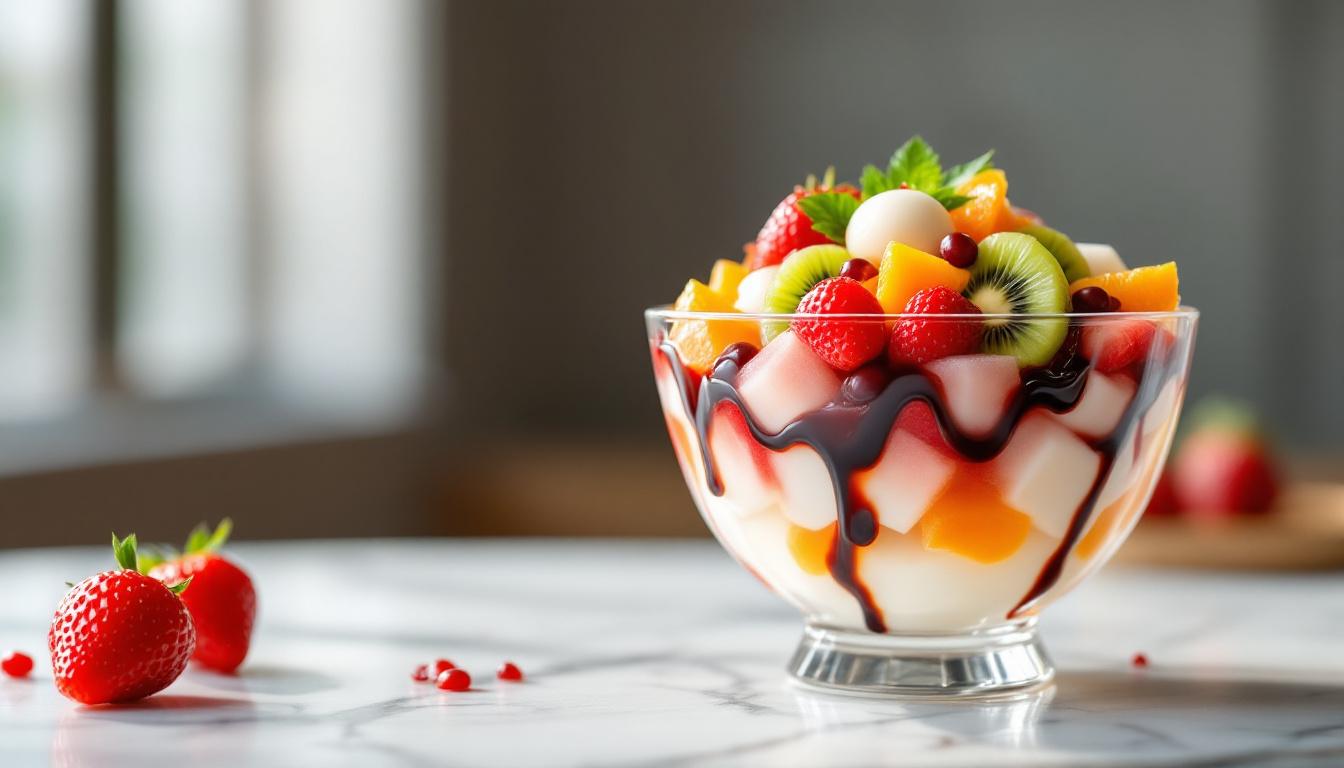I’ll never forget the first time I tasted anmitsu at a small family-owned shop in Kyoto. The delicate balance of textures – the crystal-clear wobble of kanten jelly against chewy mochi dumplings, sweet azuki beans, and the cascade of vibrant fruits – created an edible kaleidoscope that was as refreshing as it was beautiful. What surprised me most was how this seemingly complex dessert relied on simple techniques that let each ingredient shine. Today, I’ll show you how to create this quintessential Japanese summer treat that captures the essence of seasonal freshness with every spoonful.
The Story Behind Anmitsu
Anmitsu emerged during Japan’s Meiji era (1868-1912) as a luxurious dessert served in upscale establishments. The name comes from “an” (sweet bean paste) and “mitsu” (syrup). Unlike many Western desserts that rely on richness, anmitsu celebrates clarity and distinct textural contrasts – a perfect embodiment of Japanese culinary philosophy. While traditionally enjoyed during summer, I’ve found it’s a delightful palate cleanser year-round when adapted with seasonal fruits.
Ingredients Spotlight
For the kanten jelly (serves 4):
- 4g kanten powder (agar-agar) – the backbone of this dessert, creating a clearer, firmer jelly than gelatin
- 500ml (2 cups) cold water
- 1 tablespoon (15g) granulated sugar
For the sweet elements:
- 1 cup (200g) anko (sweet red bean paste) – store-bought works, but I’ll include instructions for homemade
- 8 shiratama dango (rice flour dumplings)
- 2 cups (300g) mixed seasonal fruits (strawberries, kiwi, mandarin oranges work beautifully)
- 4 tablespoons kuromitsu (black sugar syrup)
Step-by-Step Guide
1. Prepare the kanten jelly:
In a medium saucepan, combine kanten powder with cold water and let it sit for 5 minutes to soften. Heat over medium-low heat, stirring constantly but gently. Here’s where most people go wrong – do not let it boil! Maintain at around 175°F (80°C) until completely dissolved (about 5-7 minutes). Add sugar, stir until dissolved, then pour into a shallow container. Refrigerate for at least 2 hours until completely set.
2. Make shiratama dango:
Combine 100g shiratamako (glutinous rice flour) with approximately 60ml (¼ cup) water, adding it gradually while kneading until you achieve a soft, earlobe-like consistency. Roll into 8 marble-sized balls. Drop into gently boiling water and cook until they float (about 1-2 minutes). Immediately transfer to ice water to halt cooking and achieve that signature chewy texture. Drain and set aside.
Chef’s Note: The ice water bath for the dango is non-negotiable! This rapid temperature change creates that distinctive QQ texture (Taiwanese term for perfectly chewy) that elevates the entire dessert. I learned this technique from an 80-year-old confectioner in Tokyo who insisted this was the secret to proper mochi consistency.
3. Prepare homemade anko (optional):
Rinse 100g dried azuki beans and soak overnight. Drain, then simmer in fresh water for 60-90 minutes until tender. Drain, then return to pot with 50g sugar. Mash to desired consistency (traditional anmitsu uses chunky anko). Cool completely before using.
4. Make kuromitsu syrup:
Combine 100g kurozato (Japanese black sugar) or dark brown sugar with 40ml water in a small saucepan. Heat gently until sugar dissolves completely. Cool to room temperature – the syrup will thicken slightly as it cools.
Expert Assembly Techniques
Cut the kanten jelly into 1-inch cubes using a sharp knife dipped in hot water between cuts for clean edges. In individual glass bowls, arrange kanten cubes at the bottom, creating a glistening foundation. Place a generous spoonful of anko off-center – not mixed in, but beside the jelly. Arrange fruits in a colorful pattern and nestle in shiratama dango for textural contrast.
The final touch: drizzle kuromitsu over everything just before serving. This sequence matters – pouring syrup too early causes the kanten to weep and lose its structural integrity.
Presentation & Pairing Ideas
Serve anmitsu in clear glass bowls to showcase its vibrant layers. Traditionally enjoyed with matcha tea, I find it pairs surprisingly well with a crisp Gewürztraminer or even a light sparkling wine like Prosecco. For a contemporary twist, try adding a small scoop of matcha ice cream on top, creating a fusion of temperature contrasts alongside the textural ones.
For a vegan variation, try incorporating elements from my vegan pistachio baklava recipe by replacing the anko with a pistachio paste.
If you enjoy this delicate approach to dessert, you might also appreciate the silky texture of a classic French chocolate pudding or the ethereal lightness of zabaione.
The magic of anmitsu lies in its adaptability – change fruits with the seasons, experiment with different syrups like maple or honey, or even take inspiration from the marinade techniques in my Turkish kebab recipe to infuse your syrup with spices. Whatever your variation, maintain those beautiful contrasts of texture that make every spoonful of anmitsu a journey rather than just a dessert.
